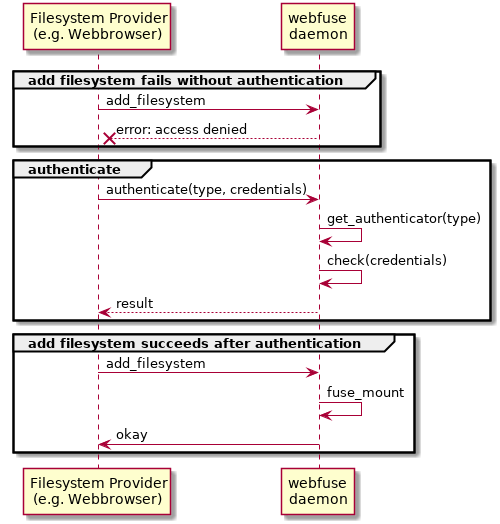2.4 KiB
Webfuse API introduction
This introduction provides a general overview to webfuse API. Please refer to the build instructions to generate API reference documentation.
Contents
Authentication
By default, webfuse daemon will redirect each filesystem call to the first connected provider without any authentication. This might be good for testing purposes or when an external authentication mechanism is used. In some use cases, explicit authentication is needed. Therefore, authentication can be enabled within webfuse daemon.
When authentication is enabled, filesystem calls are only redirected to a connected provider, after authenticate
has succeeded.
Enable authentication
Authentication is enabled, if one or more authenticators are registered via wf_server_config.
static bool authenticate(struct wf_credentials * creds, void * user_data)
{
char const * username = wf_credentials_get(creds, "username");
char const * password = wf_credentials_get(creds, "password");
return ((NULL != username) && (0 == strcmp(username, "bob")) &&
(NULL != password) && (0 == strcmp(password, "???")));
}
wf_server_config * config = wf_server_config_create();
wf_server_config_add_authenticator(config, "username", &authenticate, NULL);
wf_server * server = wf_server_create(config);
//...
Authenticator types and credentidals
Each authenticator is identified by a user defined string, called type. The type is provided by the authenticate request, so you can define different authenticators for different authentication types, e.g. username, certificate, token.
Actually, only one type is used: username
It is strongly recommended to prefix custom authenticator types with an underscore (_) to avoid name clashes.
The wf_credentialsstruct represents a map to access credentials as key-value pairs, where both, key and value, are of type string.
username
The authenticator type username is used to authenticate via username and password. Valid credentials should contain two keys.
- username refers to the name of the user
- password refers to the password of the user
Note that no further encryption is done, so this authenticator type should not be used over unencrypted websocket connections.
